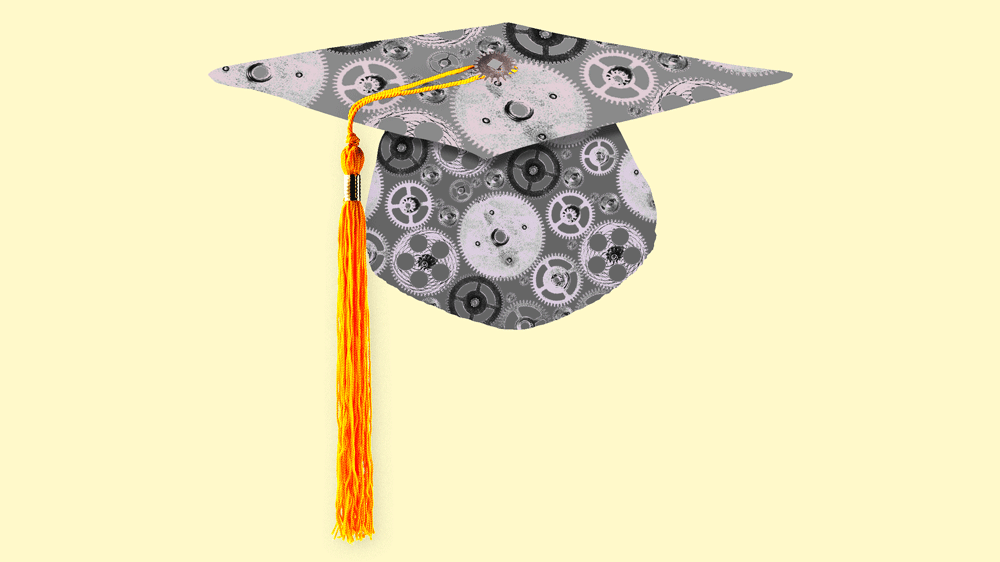Thousands of years ago, the agricultural revolution led our foraging ancestors to take up the scythe and plough. Hundreds of years ago, the Industrial Revolution pushed farmers out of fields and into factories. Just tens of years ago, the technology revolution ushered many people off the shop floor and into the desk chair and office cube.
Today, we are living through yet another revolution in the way that human beings work for their livelihoods—and once again, this revolution is leaving old certainties scrapped and smoldering on the ash heap of history. Once again, it is being powered by new technologies. But instead of the domesticated grain seed, the cotton gin, or the steam engine, the engine of this revolution is digital and robotic.
We live in a time of technological marvels. Computers continue to speed up while the price of processing power continues to plummet, doubling and redoubling the capabilities of machines. This is driving the advance of machine learning—the ability of computers to learn from data instead of from explicit programming—and the push for artificial intelligence. As economists Erik Brynjolfsson and Andrew McAfee note in their book The Second Machine Age: Work, Progress, and Prosperity in a Time of Brilliant Technologies, we have recently hit an inflection point in which our machines have reached their “full force” to transform the world as comprehensively as James Watt’s engine transformed an economy that once trundled along on ox carts. Labor experts are increasingly and justifiably worried that computers are becoming so adept at human capabilities that soon there will be no need for any human input at all.
The evidence for this inflection point is everywhere. Driverless cars are now traversing the streets of Pittsburgh, Pennsylvania, and other cities. New robots can climb stairs and open doors with ease. An advanced computer trounced the human grandmaster of the intricate Chinese strategy game Go. Moreover, it is not only the processing power of machines that has skyrocketed exponentially but also the power of their connectivity, their sensors, their GPS systems, and their gyroscopes. Today, we are giving computers not only artificial intelligence but, in effect, artificial eyes, ears, hands, and feet.
Consequently, these capacities are enabling computers to step into roles—and jobs—once held exclusively by members of our species. Robots now analyze stocks, write in deft and informative prose, and interact with customers. Semi-autonomous machines may soon join soldiers on the battlefield. In China, “co-bots”—machines that can work in factories safely alongside human beings—are upending that country’s vaunted manufacturing sector, allowing fewer laborers to be vastly more productive. In 2015, sales of industrial robots around the world increased by 12 percent over the previous year, rising to nearly a quarter of a million units.
At the same time, Big Data is revolutionizing everything from social science to business, with organizations amassing information in proportions that flirt with the infinite. Algorithms mine bottomless troves of data and then apply the information to new functions, essentially teaching themselves. Machine learning now powers everything from our spam filters to our Amazon shopping lists and dating apps, telling us what to watch, what to buy, and whom to love. “Deep learning” systems, in which artificial neural networks identify patterns, can now look at an image and recognize a chair or the face of a human individual or teach themselves how to play a video game without ever reading the instructions.
In many ways, these new technologies are an astonishing boon for humanity, giving us the power to mitigate poverty, hunger, and disease. For example, Stanley S. Litow, vice president of corporate citizenship and corporate affairs at IBM, is overseeing an initiative between Memorial Sloan Kettering Hospital in New York City and Watson, the computer that famously beat the human champions of the television game show Jeopardy! A doctor who had watched the show approached IBM with the idea to collaborate. Thus, Watson was reborn as an oncology adviser. Computer scientists at IBM embedded it with information from the hospital’s clinical trials (“not just some, all of them,” said Litow) and trained it through data analytics to respond to oncologists’ questions.
“So it proceeds as if talking to a potential patient,” said Litow. “On a mobile device I can say, ‘She has the following characteristics. Do we have any information on clinical trials that would help me figure out whether this is the problem or that is the problem?’” Watson then analyzes the data and responds to the oncologist’s question in normal English. “There’s a lot of clinical trial information, but a lot of doctors don’t have access to it,” said Litow. “It is actually helping some of the best oncologists in the United States make a better, faster diagnosis and move toward a treatment plan quickly. In treating cancer, that’s critical.”
Watson’s next challenge is to improve teaching in the New York City public school system, advising educators on effective teaching practices by using the same data analytics and communication techniques it is deploying with such success at Sloan Kettering. Technologies like Watson are helping people save lives, teach fractions, and—in their less sophisticated iterations—find the nearest parking space. They are helping people work better.
Or they are, for the moment. Automation long has been considered a threat to low-skilled labor, but increasingly, any predictable work—including many jobs considered “knowledge economy” jobs—is now within the purview of machines. This includes many high-skill functions, such as interpreting medical images, doing legal research, and analyzing data.
As advanced machines and computers become more and more proficient at picking investments, diagnosing disease symptoms, and conversing in natural English, it is difficult not to wonder what the limits to their capabilities are. This is why many observers believe that technology’s potential to disrupt our economy—and our civilization—is unprecedented.
Over the past few years, my conversations with students entering the workforce and the business leaders who hire them have revealed something important: to stay relevant in this new economic reality, higher education needs a dramatic realignment. Instead of educating college students for jobs that are about to disappear under the rising tide of technology, 21st century universities should liberate them from outdated career models and give them ownership of their own futures. They should equip them with the literacies and skills they need to thrive in this new economy defined by technology, as well as continue providing them with access to the learning they need to face the challenges of life in a diverse, global environment. Higher education needs a new model and a new orientation away from its dual focus on undergraduate and graduate students. Universities must broaden their reach to become engines for lifelong learning.
There is a great deal of evidence that we need such an educational shift. An oft-quoted 2013 study from Oxford University found that nearly half of U.S. jobs are at risk of automation within the next twenty years. In many cases, that prediction seems too leisurely. For example, new robotic algorithmic trading platforms are now tearing through the financial industry, with some estimates holding that software will replace between one-third and one-half of all finance jobs in the next decade. A 2015 McKinsey report found that solely by using existing technologies, 45 percent of the work that human beings are paid to do could be automated, obviating the need to pay human employees more than $2 trillion in annual wages in the United States.
This is not the first time we have faced a scenario like this. In past industrial revolutions, the ploughmen and weavers who fell prey to tractors and spinning jennies had to withstand a difficult economic and professional transition. However, with retraining, they could reasonably have expected to find jobs on the new factory floors. Likewise, as the Information Age wiped out large swaths of manufacturing, many people were able to acquire education and training to obtain work in higher-skilled manufacturing, the service sector, or the office park. Looking ahead, education will remain the ladder by which people ascend to higher economic rungs, even as the jobs landscape grows more complex. And it undoubtedly is getting knottier. One of the reasons for this is that the worldwide supply of labor continues to rise while the net number of high-paying, high-productivity jobs appears to be on the decline. To employ more and more people, we will need to create more and more jobs. It is not clear where we will find them.
Certainly, the emergence of new industries—such as those created in the tech sector—will have to step up if they are going fill this gap. According to the U.S. Bureau of Labor Statistics, the computer and information technology professions are projected to account for a total of 4.4 million jobs by 2024. In the same period, the labor force, age 16 and older, is expected to reach 163.7 million. Adding to the disjoint is the remarkable labor efficiency of tech companies. For instance, Google, the standard bearer for the new economy, had 61,814 full-time employees in 2015. At its peak in 1979, in contrast, General Motors counted 600,000 employees on its payroll. To address the deficit, we’ll need creative solutions.
Apart from automation, many other factors are stirring the economic pot. Globalization is the most apparent, but environmental unsustainability, demographic change, inequality, and political uncertainty are all having their effects on how we occupy our time, how we earn our daily bread, and how we find fulfillment. Old verities are melting fast. The remedies are not obvious.
Some observers have been encouraged by the growth of the “gig economy,” in which people perform freelance tasks, such as driving a car for Uber, moving furniture through TaskRabbit, or typing text for Amazon Mechanical Turk. But earnings through these platforms are limited. Since 2014, the number of people who earn 50 percent or more of their income from “gig” platforms has actually fallen. In general, these platforms give people a boost to earnings and help to pay the monthly bills. But as an economic engine, they have not emerged as substitutes for full-time jobs.
Of the new full-time jobs that are appearing, many are so-called hybrid jobs that require technological expertise in programming or data analysis alongside broader skills. Fifty years ago, no one could have imagined that user-experience designer would be a legitimate profession, but here we are. Clearly, work is changing. All these factors create a complex and unexplored terrain for job seekers, begging some important questions: How should we be preparing people for this fast-changing world? How should education be used to help people in the professional and economic spheres?
As a university president, this is no small question for me. As a matter of fact, the university I lead, Northeastern, is explicitly concerned with the connections between education and work. As a pioneer in experiential learning, grounded in the co-op model of higher education, Northeastern’s mission has always been to prepare students for fulfilling—and successful—roles in the professional world. But lately, as I have observed my students try to puzzle out their career paths, listened to what employers say they are looking for in new employees, and take stock of what I read and hear every day about technology’s impact on the world of professional work, I have come to realize that the existing model of higher education has yet to adapt to the seismic shifts rattling the foundations of the global economy.
I believe that college should shape students into professionals but also creators. Creation will be at the base of economic activity and also much of what human beings do in the future. Intelligent machines may liberate millions from routine labor, but there will remain a great deal of work for us to accomplish. Great undertakings like curing disease, healing the environment, and ending poverty will demand all the human talent that the world can muster. Machines will help us explore the universe, but human beings will face the consequences of discovery. Human beings will still read books penned by human authors and be moved by songs and artworks born of human imagination. Human beings will still undertake ethical acts of selflessness or courage and choose to act for the betterment of our world and our species. Human beings will also care for our infants, give comfort to the infirm, cook our favorite dishes, craft our wines, and play our games. There is much for all of us to do.
To that end, this book offers an updated model of higher education—one that will develop and empower a new generation of creators, women and men who can employ all the technological wonders of our age to thrive in an economy and society transformed by intelligent machines. It also envisions a higher education that continues to deliver the fruits of learning to students long after they have begun their working careers, assisting them throughout their lives. In some ways, it may seem like a roadmap for taking higher education in a new direction. However, it does not offer a departure as much as a continuity with the centuries-old purpose of colleges and universities—to equip students for the rigors of an active life within the world as it exists today and will exist in the future. Education has always served the needs of society. It must do so now, more than ever. That is because higher education is the usher of progress and change. And change is the defining force of our time.
A UNIQUELY HUMAN EDUCATION
Education is its own reward, equipping us with the mental furniture to live a rich, considered existence. However, for most people in an advanced society and economy such as ours, it also is a prerequisite for white-collar employment. Without a college degree, typical employees will struggle to climb the economic ladder and may well find themselves slipping down the rungs.
When the economy changes, so must education. It has happened before. We educate people in the subjects that society deems valuable. As such, in the 18th century, colonial colleges taught classics, logic, and rhetoric to cadres of future lawyers and clergymen. In the 19th century, scientific and agricultural colleges rose to meet the demands of an industrializing world of steam and steel. In the 20th century, we saw the ascent of professional degrees suited for office work in the corporate economy.
Today, the colonial age and the industrial age exist only in history books, and even the office age may be fast receding into memory. We live in the digital age, and students face a digital future in which robots, software, and machines powered by artificial intelligence perform an increasing share of the work humans do now. Employment will less often involve the routine application of facts, so education should follow suit. To ensure that graduates are “robot- proof” in the workplace, institutions of higher learning will have to rebalance their curricula.
A robot-proof model of higher education is not concerned solely with topping up students’ minds with high-octane facts. Rather, it refits their mental engines, calibrating them with a creative mindset and the mental elasticity to invent, discover, or otherwise produce something society deems valuable. This could be anything at all—a scientific proof, a hip-hop recording, a new workout regimen, a web comic, a cure for cancer. Whatever the creation, it must in some manner be original enough to evade the label of “routine” and hence the threat of automation. Instead of training laborers, a robot-proof education trains creators.
The field of robotics is yielding the most advanced generation of machines in history, so we need a disciplinary field that can do the same for human beings. In the pages that follow, I lay out a framework for a new discipline—“humanics”—the goal of which is to nurture our species’ unique traits of creativity and flexibility. It builds on our innate strengths and prepares students to compete in a labor market in which brilliant machines work alongside human professionals. And much as today’s law students learn both a specific body of knowledge and a legal mindset, tomorrow’s humanics students must master specific content as well as practice uniquely human cognitive capacities.
In the chapters ahead, I describe both the architecture and the inner workings of humanics, but here I begin by explaining its twofold nature. The first side, its content, takes shape in what I call the new literacies. In the past, literacy in reading, writing, and mathematics formed the baseline for participation in society, while even educated professionals did not need any technical proficiencies beyond knowing how to click and drag through a suite of office programs. That is no longer sufficient. In the future, graduates will need to build on the old literacies by adding three more—data literacy, technological literacy, and human literacy. This is because people can no longer thrive in a digitized world using merely analog tools. They will be living and working in a constant stream of big data, connectivity, and instant information flowing from every click and touch of their devices. Therefore, they need data literacy to read, analyze, and use these ever-rising tides of information. Technological literacy gives them a grounding in coding and engineering principles, so they know how their machines tick. Lastly, human literacy teaches them humanities, communication, and design, allowing them to function in the human milieu.
As noted earlier, knowledge alone is not sufficient for the work of tomorrow. The second side of humanics, therefore, is not a set of content areas but rather a set of cognitive capacities. These are higher-order mental skills—mindsets and ways of thinking about the world. The first is systems thinking, the ability to view an enterprise, machine, or subject holistically, making connections between its different functions in an integrative way. The second is entrepreneurship, which applies the creative mindset to the economic and often social sphere. The third is cultural agility, which teaches students how to operate deftly in varied global environments and to see situations through different, even conflicting, cultural lenses. The fourth capacity is that old chestnut of liberal arts programs, critical thinking, which instills the habit of disciplined, rational analysis and judgment.
Together, the new literacies and the cognitive capacities integrate to help students rise above the computing power of brilliant machines by engendering creativity. In doing so, they enable them to collaborate with other people and machines while accentuating the strengths of both. Humanics can, in short, be a powerful toolset for humanity.
This book also explores how people grasp these tools. To acquire the cognitive capacities at a high level, students must do more than read about them in the classroom or apply them in case studies or classroom simulations. To cement them in their minds, they need to experience them in the intensity and chaos of real work environments such as co-ops and internships. Just as experiential learning is how toddlers puzzle out the secrets of speech and ambulation, how Montessori students learn to read and count, and how athletes and musicians perfect their jump shots or arpeggios, it also is how college students learn to think differently. This makes it the ideal delivery system for humanics.
A new model of higher education must, however, account for the fact that learning does not end with the receipt of a bachelor’s diploma. As machines continue to surpass their old boundaries, human beings must also continue to hone their mental capacities, skills, and technological knowledge. People rarely stay in the same career track they choose when they graduate, so they need the support of lifelong learning. Universities can deliver this by going where these learners are. This means a fundamental shift in our delivery of education but also in our idea of its timing. It no longer is sufficient for universities to focus solely on isolated years of study for undergraduate and graduate students. Higher education must broaden its view of whom to serve and when. It must serve everyone, no matter their stage in life.
By 2025, our planet will count eight billion human inhabitants, all of them with human ambition, intelligence, and potential. Our planet will be more connected and more competitive than the one we know today. Given the pace of technology’s advance, we can predict that computers, robots, and artificial intelligence will be even more intricately intertwined into the fabric of our personal and professional lives. Many of the jobs that exist now will have vanished. Others that will pay handsomely have yet to be invented. The only real certainty is that the world will be different—and with changes come challenges as well as opportunities. In many cases, they are one and the same.
Education is what sets them apart.
Excerpted from Robot Proof: Higher Education in the Age of Artificial Intelligence by Joseph E. Aoun. Copyright 2017 by Joseph E. Aoun. Published by MIT Press.






